Drishyam - The Cover-Up: When Concealment Becomes Crime, Section 201 IPC Explained
A detailed legal analysis of Drishyam's Cover-Up Sequence, Explaining how it it attracts Section 201 of IPC, Evidence Concealment, Motive v. Liability, How even Concealment and Destruction of Evidence also cannot attract Criminal Liability if there is no Offence at the First Place
Author, THelawcritiQue
11/14/20258 min read


Drishyam – The Cover-Up: When Concealment Becomes Crime. Section 201 IPC Explained
Episode 2 in our series "Cinematic Jurisprudence: The Law Behind the Lens — Understanding Crime Through Fiction"
Introduction — When Morality Meets Criminal Law, Drishyam Legal Analysis
Jeethu Joseph’s Drishyam (2013), witnessed Indian cinema’s few of the most interesting and complicated legal scenarios. The scenes bring to life most compelling moral paradoxes between criminal law and morality. Georgekutty, initially a humble cable operator, film enthusiast, and family man was forced to chose between morality and criminal law, family and legal consequences when his daughter accidentally kills Varun, the spoiled son of an high ranking police officer when he tried to exploit the modesty of her and her mother. The family’s world collapses overnight.
In the earlier episode "Drishyam - Was it Murder or Private Defence" we discussed about how the initial act that leads to the unintended death of Varun is not a murder but a viable example of Right of Private Defence. But instead of showing up before the police with real facts and claiming no offence, Georgekutty feels surrendering to a system that he believes to be corrupt and unfair is never an option. So he chooses to save his family at any cost and even if he have to manipulate the entire system by concealment.
To protect his wife and daughter, he constructs an intricate web of lies, destroys evidences and crafts alibis to make his defence foolproof in the event of future investigations. The moral instinct stays clear - to protect his family, but the question is not about the moral reasons behind Georgekutty's actions. The question is whether concealment, destroying of evidence and creating alibis is liable as a punishable offence? Whether the conduct of Georgekutty be justifiable, considering that followed from something which is not an offence but proper use of Right of Private Defence?
The Legal Context — Section 201, Indian Penal Code (IPC) — Causing disappearance of evidence
“Whoever, knowing or having reason to believe that an offence has been committed, causes any evidence of the commission of that offence to disappear, with the intention of screening the offender from legal punishment, or with that intention gives any information respecting the offence which he knows or believes to be false, shall, .. be punished with .."
Note : Section 201 has been reproduced from the Indian Penal Code for purposes of reference, academic, commentary and legal analysis only. For Further clarification read official Bare Act..
In order to substantiate a conviction under section 201 of Indian Penal Code, the following ingredients must be satisfied..
Commission of Offence - It is essential that in order to attract discussion under this section, an offence must be committed.
Knowing or; Having Reason to Believe - that an offence has been committed; that means the accused must either have knowledge of the commission of an offence, or he should have a reasonable ground to believe that an offence is committed;
Causes to Disappear the Evidence (Or) Giving any Information he Knows or Believes to be False - having such knowledge or belief, causes the disappearance or destruction of any evidence related to the commission of crime; (or) he gives any informatoin connecting to the offence which he knows or believes to be false;
With Intention to Screen Offender From Legal Punishment - the accused has acted in this behalf with an intention to to screen the offender from legal punishment i,e., to assist the offender escape the clutches of criminal law.


Application of Law to "Drishyam - The Cover-Up Sequences"
In the instant case, Georgekutty knows that the offence has taken place when his wife and daughter tells him about the incident. Georgekutty satisfies the first ingredient i.e., to have knowledge or reason to believe that prima facie offence has occurred. In continuation of the same, he causes the disappearance of evidences viz., burying the dead body, destroys the cell phone, ditching the car etc., and also meticulously creates a web of lies making people believe that they are not present on the date of offence creating a strong alibi in his favour. He does all these in furtherance of his intention to protect his family from criminal liability i.e., to say to screen the offenders from lawful punishment. That means he even had the essential mental element enough to make him liable for the offence under section 201 of IPC.
Does Motive has any part to do with the Criminal Liability - In the instant case, the motive of the protagonist is crystal clear - to save his family corrupt system which he do not trust with their safety. No person shall be called evil if he wants to save his family. But having a good motive does not limit the criminal law to expand its jurisdiction over the accused. The motive of the accused even though how noble it is does not save him from being convicted. Thus, motive of the protagonist cannot save him from being held liable under section 201 of Indian Penal Code. Even considering the fact that he was not killer, his deliberate act of concealing the crime squarely falls within the ambit of Section 201 IPC.
The Moral Dilemma — When Good Faith Turns Guilty
Georgekutty’s defence is a prosecution is instituted against him, lies not in denial, but in moral justification. That his is not malicious but protecting his family. But the very intention required for this crime is intention to screen offender from punishment. Criminal law by nature is amoral. It operates on the act (actus reus) and intention (mens rea) required for the commission of the offence but not the emotional or ethical grounds of the accused to act in this behalf.
The section applies not just to private persons who tries to save their family of acquaintances but it also applies to public servants who influence the lawful procedures thereby weakening the prosecution in order to protect offenders. This was observed by the Supreme Court in –
Kodali Puranchandra Rao v. Public Prosecutor (1975) 2 SCC 570 –
Where two sisters, Kalarani and Chandrika Rani were disappeared and were later found dead, the Sub-Inspector (A-2) instead of investigating the offence, falsified the inquest, caused disappearance of a dead body, and created false records to disguise the suspicious deaths. The Supreme Court held that the evidence on record clearly shows that its not just negligence but intentional suppression and disappearance of evidences with an intention to shield the real offenders from the eyes of law. The Court therefore upheld the convictions under Sections 201, 218, and 468 IPC, categorically stating that police officers and public servants who manipulate investigations to screen offenders shall face strict legal consequences.
Other Offences that are Attracted in this "Cover-Up Sequence"
The essence of criminal law is that when a criminal act is done, it not only attracts one offence that is punishable as a crime but if the ingredients satisfy other offences, the accused shall be deemed to have committed other offences also. In our movie the conscientious and calculated concealment of evidences by Georgekutty doesn’t end with Section 201. The act unravels other offences under the IPC intertwined in the same sequence :
Section 202 IPC – Intentional omission to give information of an offence. - When a person who knows or having reason to believe about the commission of a congnizable offence and has obligation to report it, intentionally failed to report as said to have committed an offence under this section. Georgekutty never informed the authorities despite knowing of the death.
Section 203 IPC – Giving false information to screen an offender. - In the same circumstances if a person gives an information or statement which he knows or have reason to believe to be false with an aim to screen offender are liable under this section. His false statements and planted alibis constitute this offence.
Section 120B IPC – Criminal conspiracy. - Two or more people conspiring together to commit an act which is a crime are said to have committed criminal conspiracy. The family's collective plan to deceive the system comes under this section.
Section 204 IPC – Destruction of document or electronic record.- Here destruction of victim's belongings to avoid them being used as an evidence in a criminal trail attract punishment under this section.


No Prima Facie Offence Made Out at the First Place - Nothing That Follows is an Offence..
It is not the moral or emotional grounds but a clean technical glitch that comes to the rescue of Georgekutty and his family even after the well structured concealment, deception and destruction of evidences. When studied section 201 of IPC earlier, we must carefully observe one initial point where the entire crux of the section lies. It says "whoever knows or has reason to believe than an offence has been committed.." which actually mean that a prima facie offence must have taken place earlier. If we refer to our previous episode where argued that the accidental death of Varun can be pleaded as a genuine and lawful use of right of private defence, clearly indicate that there was no prima facie offence made out at the first place itself.
Let us study this in further detail by refering Palvinder Kaur v. State of Punjab (1952 SCR 94), case. The facts include - When Palvinder Kaur’s husband died the accused went panic and in order to avoid investigation, she hid the body in a trunk filled with water. During trail, the prosecution relied on confession given by her which contained both inculpatory and exculpatory parts. The Court held that a statement of confession cannot be split to take only the parts which were against the accused and they must be accepted as a whole. Since the confession itself did not conclusively prove murder, the accused could not be convicted for the offence of murder under Section 302 IPC. In addition to acquitting her under Section 302, relying on this, Supreme Court also ruled that the accused could not be convicted under Section 201 IPC unless the foundational offence i.e., murder was independently proved. As a result Palvinder Kaur was acquitted for both offences.
Relying of this we can strongly argue that there is no prima facie offence made out at the first place and therefore the conduct following it shall not be proved unless the initial act was concluded as murder or culpable homicide not amounting to murder.
Our CritiQue : A Crime Without a Criminal?
The emotional journey of Georgekutty in Drishyam can be a subjective study of how humans behave instinctively to the situations endangering their family, life or reputation. This can be understood as an example to study the loopholes in the present day criminal jurisprudence. While the law fails to protect the individuals by applying the procedure unbiased, individuals approach to take escape routes even if it is at the cost of manipulating the law.
Though the accidental death may be justified by applying Right of Private Defence, what follows is undeniably a deliberate concealment and deception that affects the ingredients of the offences within the framework of Section 201, Section 202, Section 203, and other related provisions of the IPC.
However, the legal defence to protect Georgekutty and his family arises from a technical cornerstone: If no prima facie offence exists at the core, the concealment of it also is not a crime. Thus the consider if a prosecution even though initiated for the said offence shall establish that the previous incident attracts murder only when the subsequent conduct also shall attract liability. If the prosecution failed to establish murder, then Section 201 also shall dismiss accordingly.
Connect With Us Through
Connect with us
© 2025. All rights reserved.
